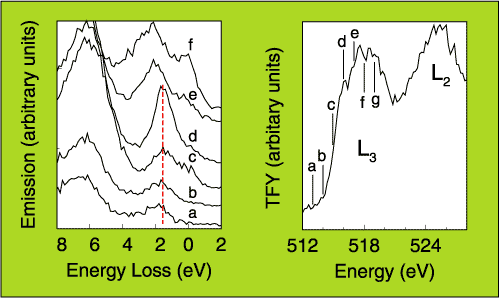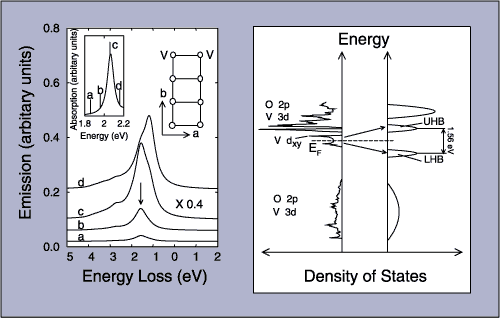
RIXS Technique Measures Hubbard Interaction
The Hubbard interaction term U is a measure of the strength of the repulsion between electrons in certain solids, but direct measurements of its value have been difficult. Now, scientists from the University of Tennessee, Knoxville, and the Oak Ridge National Laboratory have used the technique of resonant inelastic x-ray scattering (RIXS) at the Advanced Light Source to make a particularly clean measurement of the Hubbard U in sodium vanadate (NaV2O3). They were also able to calculate a value for U in this material, so their measurement makes possible a direct comparison between theory and experiment. In this case, theory and experiment turn out to be in good agreement, thereby suggesting that RIXS provides useful information for solids with strong electron-electron interactions.
|
Multielement oxide compounds containing transition metals variously known as complex materials or strongly correlated materials are at the forefront of today's solid-state science. On the level of fundamental understanding, they have for many decades defied theorists' efforts to model them accurately, owing to the large electron-electron interaction that casts into doubt the applicability of the conventional energy-band models of solids (both conventional one-electron and more sophisticated quasi-particle varieties). At the same time, these materials exhibit a wondrous variety of phenomena signaled by phase transitions and collective or many-body effects of various types, some of which potentially have commercial overtones, such as the high-temperature superconductivity and colossal magnetoresistance that result by doping the parent compounds with small concentrations of additional elements. In thinking about strongly correlated materials, theorists frequently start from the Hubbard model, a simplified scheme that contains a single parameter, the Hubbard interaction term U, to characterize electron-electron repulsion. When U is large, a partially occupied band straddling the Fermi energy can split into two Hubbard bands, producing an energy gap that converts what was a metal into a Mott insulator. In real Mott insulators, the many energy bands traceable to electrons originating from the different atomic shells (s, p, d, etc.) can overlap, so that extracting the splitting between the Hubbard bands is not so easy. |
When Waltzing Electrons Head for Opposite Sides of the Dance Floor |
Study of sodium vanadate overcomes this problem because there is a single well-defined band at the Fermi level before the strong electron-electron interaction is taken into account. But it introduces a new complication for optical absorption spectroscopy of the Hubbard bands because quantum-mechanical selection rules prohibit transitions excited by absorption of a single photon between electron states with the same angular momentum. The Tennessee/Oak Ridge collaboration attacked the selection-rule problem with RIXS, which is a two-photon soft x-ray technique in which the first photon can excite an electron from a core state to the upper Hubbard band and the second photon is that emitted when an electron in the lower Hubbard band falls into the hole (missing electron) in the core state.
In inelastic x-ray scattering (left), researchers measure the intensity of the emitted x rays as a function of the energy loss (difference between the energies of the absorbed and emitted x rays) for several excitation energies (indicated by the lower case letters in the total fluorescent yield spectrum, right). The emission peak (dotted line) that is independent of excitation energy is due to resonant inelastic scattering (RIXS). In measurements at ALS Beamline 8.0.1, the group excited electrons from vanadium 2p core states (vanadium L edges). The resulting x-ray emission spectra contained two prominent features over a small photon-energy range that could be distinguished by watching how peak positions changed with excitation energy. In this way, they isolated the emission peak due to excitation into the upper Hubbard band followed by recombination from the lower band. Both bands derive from vanadium d states (or more specifically, dxy states). From the energy difference between the inelastic and elastic (emitted photon energy is the same as the excitation energy) peaks, they derived the energy splitting between the bands. Their calculation based on a simple cluster model of sodium vanadate with the Hubbard interaction term U as a variable parameter, yielded good agreement between experimental and theoretical energy splittings and hence a value for U.
Comparison of the experimental emission spectra and those calculated for a simple model of sodium vanadate (left) identifies the RIXS peak as due to excitation to and recombination from the upper and lower Hubbard bands that arise from electron correlation (right). Letters indicate the excitation photon energy. A value of 3.0 eV for the Hubbard interaction term U was also obtained. Research conducted by G.P. Zhang (University of Tennessee, Knoxville, and State University of New York, College at Buffalo); T.A. Callcott, G.T. Woods, and L. Lin (University of Tennessee, Knoxville); and B. Sales, D. Mandrus, and J. He (Oak Ridge National Laboratory). Research funding: National Science Foundation and U. S. Department of Energy, Office of Basic Energy Sciences (BES). Operation of the ALS is supported by BES. Publication about this research: G.P. Zhang, T.A. Callcott, G.T. Woods, L. Lin, B. Sales, D. Mandrus, J. He., "Electron Correlation Effects in Resonant Inelastic X-Ray Scattering of NaV2O3," Phys. Rev. Lett. 88, 077401 (2002). |
|
More ALS Science

